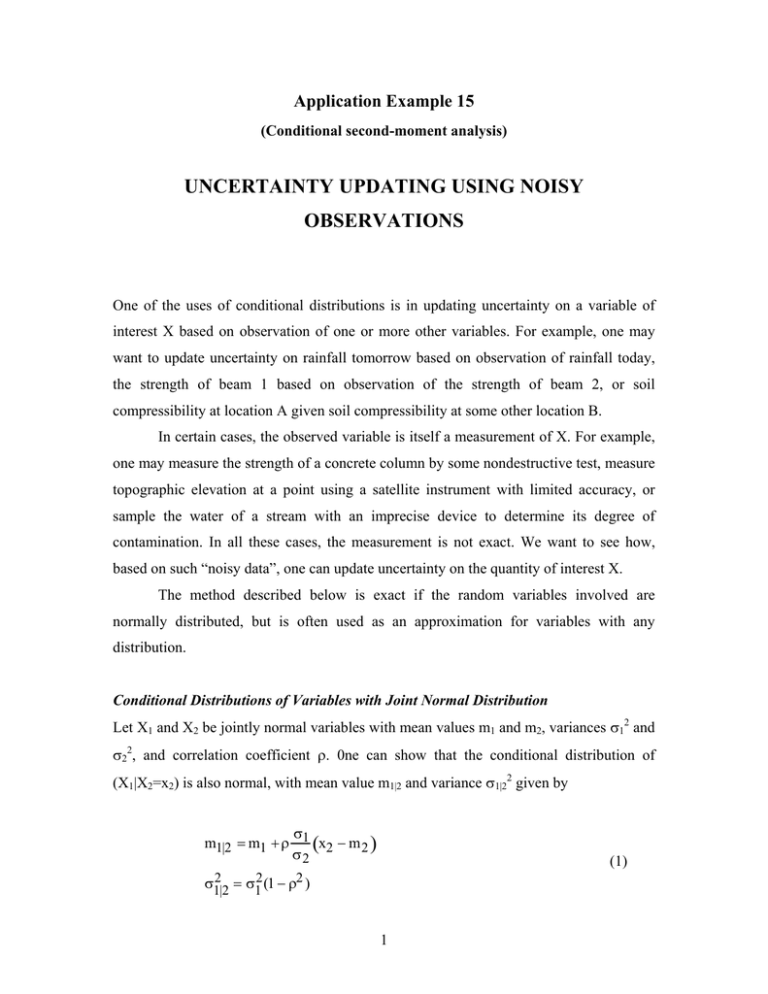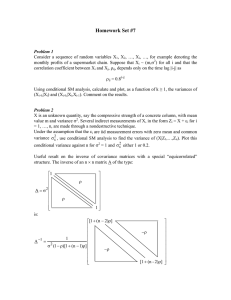UNCERTAINTY UPDATING USING NOISY OBSERVATIONS Application Example 15
advertisement

Application Example 15
(Conditional second-moment analysis)
UNCERTAINTY UPDATING USING NOISY
OBSERVATIONS
One of the uses of conditional distributions is in updating uncertainty on a variable of
interest X based on observation of one or more other variables. For example, one may
want to update uncertainty on rainfall tomorrow based on observation of rainfall today,
the strength of beam 1 based on observation of the strength of beam 2, or soil
compressibility at location A given soil compressibility at some other location B.
In certain cases, the observed variable is itself a measurement of X. For example,
one may measure the strength of a concrete column by some nondestructive test, measure
topographic elevation at a point using a satellite instrument with limited accuracy, or
sample the water of a stream with an imprecise device to determine its degree of
contamination. In all these cases, the measurement is not exact. We want to see how,
based on such “noisy data”, one can update uncertainty on the quantity of interest X.
The method described below is exact if the random variables involved are
normally distributed, but is often used as an approximation for variables with any
distribution.
Conditional Distributions of Variables with Joint Normal Distribution
Let X1 and X2 be jointly normal variables with mean values m1 and m2, variances σ12 and
σ22, and correlation coefficient ρ. 0ne can show that the conditional distribution of
(X1|X2=x2) is also normal, with mean value m1|2 and variance σ1|22 given by
σ
m1|2 = m1 + ρ 1 (x2 − m 2 )
σ2
(1)
2 = σ 2 (1 − ρ2 )
σ1|2
1
1
Notice that the conditional mean depends on the observed value x2 of X2, whereas the
conditional variance does not.
Moreover, the conditional variance differs from the
unconditional variance by the factor (1 - ρ2), which is smaller than 1 whenever X1 and X2
are dependent.
Application to Noisy Observations
Next we show how Eq. 1 can be used to update uncertainty on a quantity of interest X
(e.g., X = load bearing capacity of the soil or concentration of a pollutant at a given
location) after making a measurement of it.
The quantity of interest, X, is initially uncertain with mean value m and variance
σ2. To reduce this uncertainty (and for example determine whether X is below a critical
level x* with probability at least P*), a measurement Z of X is made. If the measurement
had no error, then X could be recovered exactly from Z, but in practice measurements are
affected by errors (they are “noisy”). A simple model with noise is the so-called linear
model, according to which Z is related to X as
Z = a + bX + ε
(2)
where a and b are given deterministic constants and ε is an error term independent of X,
with mean value zero and variance σε2. The problem is to update uncertainty on X based
on the observed value of Z, say z.
To use the conditional moment results in Eq. 1, we need to find the mean value
and variance of Z and the correlation coefficient between X and Z. After this is done, we
may rename X → X1 and Z → X2 and use that equation. Second-moment propagation of
uncertainty through linear functions gives
mZ = a + bm
σZ2 = b2σ2 + σε2
(3)
Cov[X,Z] = bσ2
2
Using these results and the relationships
σ
ρσ σ
Cov[X1 ,X2 ]
ρ 1 = 12 2 =
Var[X 2 ]
σ2
σ
2
(4)
{Cov[X1 ,X2 ]}2
2
2
σ1 (1− ρ ) = Var[X1] −
Var[X2 ]
one obtains from Eq. 1:
E[X Z = z] = m + h
⎡z − a
⎤
−m
⎣⎢ b
⎦⎥
(5)
Var[X Z = z]= σ 2 (1− h)
−1
⎛
σ 2ε ⎞
where h = ⎜ 1 − 2 2 ⎟ . Like Eq. 1, Eq. 5 holds exactly if both X and ε have normal
b σ ⎠
⎝
distribution and in approximation for other distributions.
A key role in Eq. 5 is played by the quantity h, for which some special cases may
be noted:
1. suppose that σε2 = 0, or more in general that σε2 << b2σ2.
This means that
observations are without error or the contribution from X to the variance of Z far
exceeds the contribution from ε (high “signal-to-noise ratio”). In this case h = 1 and
Eq. 5 gives E[X|Z = z] = (z - a)/b and Var[X|Z = z] = 0. This is of course the
solution to the deterministic problem;
2. At the other extreme is the case of very noisy measurements, when σε2 >> b2σ2. In
this case h is close to zero and Eq. 5 gives E[X|Z = z] = m and Var[X|Z = z] = σ2, i.e.
no change in the state of uncertainty on X as a result of observing Z.
3
Problem 15.1
(a) Cases of practical interest are intermediate between the above two limiting cases. To
understand the role of different factors in the informativeness of a linear experiment,
set b = 1 and plot the posterior-to-prior variance ratio γ = Var[X|Z = z]/σ2 against
σε2/b2σ2. Notice that γ is a measure of the information value of the experiment and
that the ratio σε2/b2σ2 can be decreased by either reducing the variance of the
measurement error σε2 or increasing the “gain” b.
(b) Think of an application of the observation model presented above to a context of
interest to you. Postulate a plausible prior uncertainty state and realistic observation
model parameters.
Derive the uncertainty updating equation and the posterior
variance using Eq. 5.
Problem 15.2
(a) Extend the previous analysis to the vector case, i.e. consider X to be a vector with n
components and Z to be a vector with r components. Assume a linear relation
between X and Z of the type Z = a + BX + ε, where a is a given vector, B is a given
matrix, and ε is a random measurement error vector. Assume that X has joint normal
distribution, ε has joint normal distribution, and X and ε are independent.
(b) Extend the results for Part (a) to include dependence between X and ε.
Best Linear Unbiased Estimation (BLUE) Theory
Equation 1 is often used also when X1 and X2 do not have joint normal distribution. In
that case Eq. 1 may be regarded as an approximation or may be used with a different
interpretation. Specifically, we show that, irrespective of the type of distribution, the
expression for the conditional mean in Eq. 1 has the meaning of best linear unbiased
estimator of X1 from X2 and the conditional variance in Eq. 1 has the meaning of
associated estimation error variance.
4
Suppose that X1 and X2 have mean values, variances, and correlation coefficient
as above, but are not necessarily normally distributed. Based on the observation of X2,
ˆ = a + bX2, and look for coefficients a and b such
we form a linear estimator of X1, X
1
that
ˆ ] = E[X1] = m1. This gives a +
1. The estimator is (unconditionally) unbiased, i.e. E[ X
1
bE[X2] = a + bm2 = m1. Therefore, a = m1 - bm2.
ˆ has minimum error variance. The error is
2. Among all linear unbiased estimators, X
1
ˆ - X1 and its variance is σ 2 = var[bX − X ] = σ 2 + b 2σ 2 − 2bρσ σ . Taking
e= X
1
e
2
1
1
2
1 2
the derivative with respect to b and setting it to zero gives 2bσ 22 − 2ρσ1σ 2 = 0 .
Hence b = ρ σ1/σ2 and a = m1 - ρ m2 (σ1/σ2).
We conclude that the BLUE estimator of X1 from X2 is
ˆ = m1 + ρ(σ1/σ2)(x2 - m2)
X
1
(6)
The associated error variance is obtained by substituting b = ρ σ1/σ2 into the expression
for σ 2e . This gives
σe2 = σ12(1 - ρ2)
(7)
Comparison of Eqs. 6 and 7 with Eq. 1 shows that the BLUE estimator for any joint
distribution of X1 and X2 is identical to the conditional mean m1|2 for jointly normal
variables and that the conditional variance in Eq. 1 is also the error variance of the BLUE
estimator. This correspondence significantly broadens the applicability of the normal
distribution results.
5









